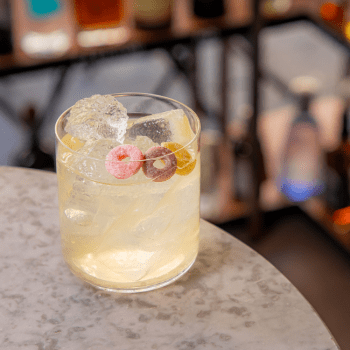A drink with… Ciarán Smith
Irish bartender Ciarán Smith has created a cocktail menu based on customer-driven data taken over a year. SB dropped by his venue, The Bottle Cocktail Shop, in London’s Islington to find out the results.

Smith (who co-founded Irish bar Homeboy, also in Islington) opted for the long game to craft his menu – rather than rushing in and assuming what the customer wants, he took a step back and observed what his drinkers desire. Since leaving Homeboy in Islington and closing the venue’s second outpost in Battersea last year, he opened The Bottle Cocktail Shop in 2022.
First off, can you explain the concept of the shop?
It’s a hybrid between a bottle shop and a cocktail bar. I used to own a cocktail bar [Homeboy] in London for four-and-a-half years and, during Covid, we had to close down [temporarily]. As off-licences were seen as essential businesses, I thought to myself: “We’re basically doing the same things but in different formats”. If something like that were to happen again, I felt like I would need to look at a different approach for the next venue. That’s how we came up with the idea of The Cocktail Bottle Shop – looking at an off-licence, but recreated in my image.
We’re untraditional for a bottle shop; for every subcategory, we only hold two brands. We use the WSET [Wine & Spirits Education Trust] allocation process for our products. For example, for Irish whiskey, we have blended, single malt, single grain and pot still. For blended, we have a very good blend and an outstanding blend – and that’s it. You only get two choices. It takes choice fatigue away from the consumer as it can be quite daunting walking into a big bottle shop and being faced with 100 London Drys and so on. It’s daunting even for people who know a lot about booze, so we’re trying to take that barrier away from customers. We found it leads to more questions and builds trust, too.
When you say the menu is ‘hyper-personalised’, what do you mean?
We wanted to make a menu that was hyper-personalised to our guests, where, instead of trying to anticipate what the customer wants, we would take a year out to actually understand what our customer likes to drink and then offer that.
How did you compile the final menu?
We decided to offer our guests five cocktails that rotated every month. That allowed us to play around with various spirit combinations and figure out what exactly the consumer likes. For a whole year, every month we rotated five drinks – we ended up doing around 60 drinks by the end of it. In December, we printed off all the cocktails that we sold so we could pinpoint the bestsellers and build our menu of 16 drinks around that.
What benefits have you seen from doing this?
Instead of having a cocktail menu that is 16 to 20 drinks and you only have five fast-movers out of the 16, the idea here is that the whole menu will be a ‘fast-mover’. In the first year of trading, we found that guests like to drink more delicate styles. For example, our Milk Punch was one of our biggest sellers last year, and the Daisy cocktail too, plus things with very light and bright citrus notes. That’s what you will find throughout the menu – a lot of lighter-style drinks.

What cocktail trends have you noticed from the project? What are customers leaning towards at the moment?
Wine is getting quite popular with cocktails. We have two drinks on the menu that feature wine. Last year, we played around with different wines and styles of wine in cocktails, especially in summer. One of the ones we have here is called Feels Like Summer, which I would probably best describe as a long fresh Bramble. Then there’s the Unhinge, which has tonic wine and plum wine syrup. It adds a depth of character and flavour – more so when you bring red wine into cocktails. Wine brings those tannins through, which have a lovely mouthfeel.
There’s also coffee, and we have two coffee-based cocktails on the menu, as they were two of our top-selling drinks from last year. One is an Espresso Martini (of course) and the other is an Irish Coffee, which is called the Irish American.
I used to live in New York – thinking about the Irish diaspora there and loving Irish Coffee myself, I wanted to play on those two things. We use Glendalough Double Barrel, which is a single-grain Irish whiskey, and Yellowstone Kentucky Bourbon. You need to give a little more ABV to stand up against the coffee. We make a 36-hour homebrewed cold brew and then add a little bit of Demerara cream with nutmeg to top it all off.
What else is popular?
Even though I was talking about lighter drinks before, we do have two drinks on the menu that are quite ‘stirred down’ and brown – not what I would call ‘flavour forward’. As I mentioned, one is called Unhinge, which has plum and tonic wine syrup, plus Amaro Montenegro and orange bitter, stirred down. It’s super delicious.
If you like a Dirty Martini, we’ve made what we call a Maritime Martini. We use an Irish gin called An Dúlamán, which is a seaweed gin, and then we make a kombu tincture as well. It has a lot of salinity and earthy flavours, but the earthiness of the sea. A lot of Martini drinkers go straight for it on the weekends.
Related news
Emanuele Mensah on winning Diageo World Class GB
